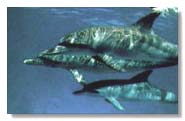Association patterns: Measuring frequency, duration and proximity between dolphin calves and associates in Roatan, Honduras and Bimini, The Bahamas
Dolphin calves typically bond with other individuals in the group in which they live.From these associates, calves learn survival skills and social behaviors such as foraging,play behaviors, and signals used to share information as well as the overall social

structure of the group. During the Dolphin Communication Project’s data collection,calves of three delphinid species have been observed to associate with different individual dolphins, not limited to their mothers. A few researchers (Herzing, 1990;Mann, Janet; Masaki, et al. 2005) have observed “babysitting” or alloparenting among dolphins: this is broadly defined as one adult female watching over another’s calf while the latter takes turns feeding and watching. Several body positions may be seen during alloparenting as well as other associations but most noticeably are the infant and echelonpositions. Infant position swimming is defined as the infant swimming under the mother in contact with her abdomen while echelon swimming is defined as the infant swimming alongside the mother, roughly parallel, just above her midline (Simard 2004).
Mom and Calf
{flv}MomJuvenileswim{/flv}
This present study examines the frequency, duration and proximity of calf associations with other individual dolphins. Data are collected through field research organized by the Dolphin Communication Project at two field sites with two dolphin species represented:
a group of 18 Atlantic bottlenose dolphins (Tursiops trunctatus) in human care at the Roatan Institute for Marine Sciences (RIMS) in Roatan, Honduras and a sub-population of approximately 100 wild Atlantic spotted dolphins (Stenella frontalis) that frequent the water off the coast of Bimini, The Bahamas. Data are gathered with a mobile underwater/acoustic system (MVA) following a protocol of focal follows and all occurrence sampling (Dudzinski et al., 1995).Independent variables include calf age and sex and identification of associates including age and sex. Dependent variables are duration and proximity of associations. Other factors that are noted include dolphin body positioning with respect to other dolphins and any novel behaviors exhibited at the time of each documented association.Age classifications define a calf as 0 to 3-5 years of age (estimates based on Perrin 1970and Herzing 1991). For this study, calf age is broken into 3 groups: 0-1 year, 1-2 years and 2-3 years. Three consecutive years of data (2003, 2004 and 2005) from each field site will be analyzed. Because of this, focus will be placed on how a calf’s behavior may change as it ages and their development skills progress. The null hypotheses of this research study are there is no significant difference in frequency, duration and proximity of calves and associates between wild and captive populations, male and female calves and between the ages of calves.
Mom and Calf
{flv}MomnudgesJuvenile{/flv}
Literature cited
Dudzinski, K.M., C.W. Clark and B. Wursig (1995). “A mobile video/acoustic system for simultaneous underwater recording of dolphin interactions.” Aquatic Mammals 21(3): 187-193.
Herzing, D.L. (1990) Underwater and close up with spotted dolphins. Whalewatcher 24, 16-19.
Herzing, D.L. and B.J. Brunnick (1997). Coefficients of association of reproductively active female Atlantic spotted dolphins, Stennela frontalis.” Aquatic Mammals 23(3): 155-162.
Masaki, Keiko, Hishii Toru, Kurimoto Michio, Yoshioka Motoi and Kashiwagi Masaaki. “Change of proximity between mothers and their calves by the age of the calf in wild Indo-Pacfic bottlenose dolphins (Tursiops aduncus).”
Perrin, W.F. (1970) Color patter of the eastern Pacific spotted porpoise Stenella graffmani Lonnberg (Cetacea, Delphinidae). Zoology 54, 135-142.
Simard, Peter (2004). “Two calves in echelon: An alloparental association in Atlantic white-sided dolphins (Lagenorhynchus acutus).” Aquatic Mammals 30(2): 330-334.
Post Views: 13,866
 structure of the group. During the Dolphin Communication Project’s data collection,calves of three delphinid species have been observed to associate with different individual dolphins, not limited to their mothers. A few researchers (Herzing, 1990;Mann, Janet; Masaki, et al. 2005) have observed “babysitting” or alloparenting among dolphins: this is broadly defined as one adult female watching over another’s calf while the latter takes turns feeding and watching. Several body positions may be seen during alloparenting as well as other associations but most noticeably are the infant and echelonpositions. Infant position swimming is defined as the infant swimming under the mother in contact with her abdomen while echelon swimming is defined as the infant swimming alongside the mother, roughly parallel, just above her midline (Simard 2004).
structure of the group. During the Dolphin Communication Project’s data collection,calves of three delphinid species have been observed to associate with different individual dolphins, not limited to their mothers. A few researchers (Herzing, 1990;Mann, Janet; Masaki, et al. 2005) have observed “babysitting” or alloparenting among dolphins: this is broadly defined as one adult female watching over another’s calf while the latter takes turns feeding and watching. Several body positions may be seen during alloparenting as well as other associations but most noticeably are the infant and echelonpositions. Infant position swimming is defined as the infant swimming under the mother in contact with her abdomen while echelon swimming is defined as the infant swimming alongside the mother, roughly parallel, just above her midline (Simard 2004).